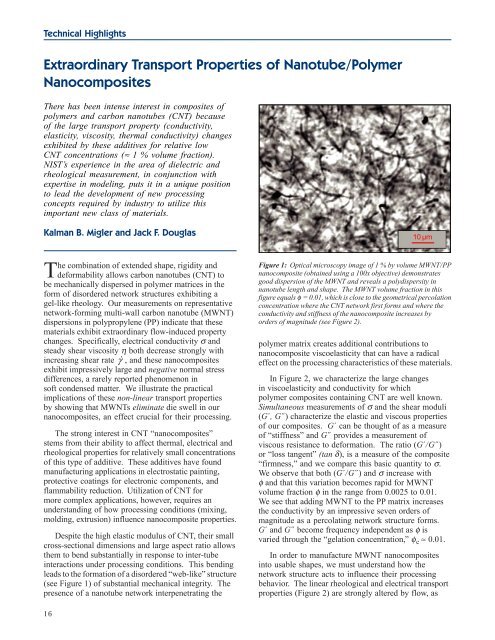Materials Science and Engineering Laboratory FY 2004 ... - NIST
Materials Science and Engineering Laboratory FY 2004 ... - NIST
Materials Science and Engineering Laboratory FY 2004 ... - NIST
You also want an ePaper? Increase the reach of your titles
YUMPU automatically turns print PDFs into web optimized ePapers that Google loves.
Technical Highlights<br />
Extraordinary Transport Properties of Nanotube/Polymer<br />
Nanocomposites<br />
There has been intense interest in composites of<br />
polymers <strong>and</strong> carbon nanotubes (CNT) because<br />
of the large transport property (conductivity,<br />
elasticity, viscosity, thermal conductivity) changes<br />
exhibited by these additives for relative low<br />
CNT concentrations (≈ 1 % volume fraction).<br />
<strong>NIST</strong>’s experience in the area of dielectric <strong>and</strong><br />
rheological measurement, in conjunction with<br />
expertise in modeling, puts it in a unique position<br />
to lead the development of new processing<br />
concepts required by industry to utilize this<br />
important new class of materials.<br />
Kalman B. Migler <strong>and</strong> Jack F. Douglas<br />
The combination of extended shape, rigidity <strong>and</strong><br />
deformability allows carbon nanotubes (CNT) to<br />
be mechanically dispersed in polymer matrices in the<br />
form of disordered network structures exhibiting a<br />
gel-like rheology. Our measurements on representative<br />
network-forming multi-wall carbon nanotube (MWNT)<br />
dispersions in polypropylene (PP) indicate that these<br />
materials exhibit extraordinary flow-induced property<br />
changes. Specifically, electrical conductivity σ <strong>and</strong><br />
steady shear viscosity η both decrease strongly with<br />
increasing shear rate γ& , <strong>and</strong> these nanocomposites<br />
exhibit impressively large <strong>and</strong> negative normal stress<br />
differences, a rarely reported phenomenon in<br />
soft condensed matter. We illustrate the practical<br />
implications of these non-linear transport properties<br />
by showing that MWNTs eliminate die swell in our<br />
nanocomposites, an effect crucial for their processing.<br />
The strong interest in CNT “nanocomposites”<br />
stems from their ability to affect thermal, electrical <strong>and</strong><br />
rheological properties for relatively small concentrations<br />
of this type of additive. These additives have found<br />
manufacturing applications in electrostatic painting,<br />
protective coatings for electronic components, <strong>and</strong><br />
flammability reduction. Utilization of CNT for<br />
more complex applications, however, requires an<br />
underst<strong>and</strong>ing of how processing conditions (mixing,<br />
molding, extrusion) influence nanocomposite properties.<br />
Despite the high elastic modulus of CNT, their small<br />
cross-sectional dimensions <strong>and</strong> large aspect ratio allows<br />
them to bend substantially in response to inter-tube<br />
interactions under processing conditions. This bending<br />
leads to the formation of a disordered “web-like” structure<br />
(see Figure 1) of substantial mechanical integrity. The<br />
presence of a nanotube network interpenetrating the<br />
16<br />
Figure 1: Optical microscopy image of 1 % by volume MWNT/PP<br />
nanocomposite (obtained using a 100x objective) demonstrates<br />
good dispersion of the MWNT <strong>and</strong> reveals a polydispersity in<br />
nanotube length <strong>and</strong> shape. The MWNT volume fraction in this<br />
figure equals φ = 0.01, which is close to the geometrical percolation<br />
concentration where the CNT network first forms <strong>and</strong> where the<br />
conductivity <strong>and</strong> stiffness of the nanocomposite increases by<br />
orders of magnitude (see Figure 2).<br />
polymer matrix creates additional contributions to<br />
nanocomposite viscoelasticity that can have a radical<br />
effect on the processing characteristics of these materials.<br />
In Figure 2, we characterize the large changes<br />
in viscoelasticity <strong>and</strong> conductivity for which<br />
polymer composites containing CNT are well known.<br />
Simultaneous measurements of σ <strong>and</strong> the shear moduli<br />
(G´, G´´) characterize the elastic <strong>and</strong> viscous properties<br />
of our composites. G´ can be thought of as a measure<br />
of “stiffness” <strong>and</strong> G´´ provides a measurement of<br />
viscous resistance to deformation. The ratio (G´/G´´)<br />
or “loss tangent” (tan δ), is a measure of the composite<br />
“firmness,” <strong>and</strong> we compare this basic quantity to σ.<br />
We observe that both (G´/G´´) <strong>and</strong> σ increase with<br />
φ <strong>and</strong> that this variation becomes rapid for MWNT<br />
volume fraction φ in the range from 0.0025 to 0.01.<br />
We see that adding MWNT to the PP matrix increases<br />
the conductivity by an impressive seven orders of<br />
magnitude as a percolating network structure forms.<br />
G´ <strong>and</strong> G´´ become frequency independent as φ is<br />
varied through the “gelation concentration,” φ c ≈ 0.01.<br />
In order to manufacture MWNT nanocomposites<br />
into usable shapes, we must underst<strong>and</strong> how the<br />
network structure acts to influence their processing<br />
behavior. The linear rheological <strong>and</strong> electrical transport<br />
properties (Figure 2) are strongly altered by flow, as

















